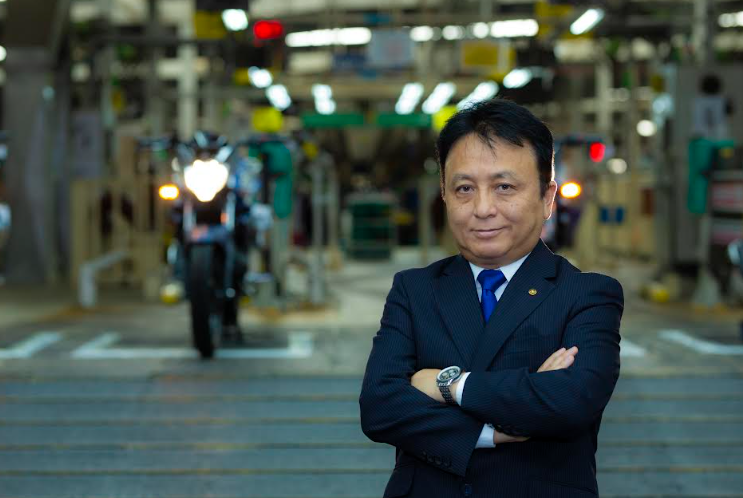
Motofumi Shitara will be taking over as the next President and CEO of Yamaha Motor Co on March 25. He is no stranger to India given that he was Group Chairman here between 2018 and 2021.
During his four-year tenure, Shitara focused on putting the Yamaha India house in order. The top priority was to build a healthy balance sheet which could only come about with better margins on two-wheelers.
Shitara was also quick to infer that it was equally important to reinforce the Yamaha DNA within the psyche of Indian consumers. The Japanese automaker had erred earlier in throwing its hat into the commuter space which was the most voluminous product category in India.
The new Chairman decided that Yamaha needed to just keep its eye on the premium category which defined its basic character as a two-wheeler maker. It was as critical to extend this message at the retail end which led to the creation of Blue Square outlets.
Market differentiator
All this along with a host of other initiatives like the Call of the Blue campaign helped Yamaha shed its former image of being yet another player in the Indian two-wheeler segment. The transition to a premium manufacturer pleased customers who could now relate to Brand Yamaha as a market differentiator.
The climb back from irrelevance was slow but steady and the company still needs to cover a lot more ground in order to be a serious contender in a market dominated by Honda and local brands like Hero, TVS and Bajaj. Yamaha and Suzuki trail behind these players but this is of little consequence since even a minuscule share is still sizable in the world’s largest two-wheeler market.
Shitara gave his first ever media interview in India to this writer sometime in the first half of 2018 when he had settled down reasonably well into his new role as Chairman. He was remarkably candid when he said that Yamaha needed to improve its presence in India which meant standing out in the crowd and being “better recognised” as a brand.
“We need to be more appealing. The most important task for Yamaha in India is recognition of the brand. It is quite apparent that the message has not quite reached the customer in the way it is intended to,” he said.
New branding exercise
This is when Shitara made known that the branding exercise would kick off with the blue colour that was synonymous with Yamaha Motor Racing in MotoGP. “This is not seen in India and I want to bring this image here,” he said.
Shitara also reiterated that the other imperative was a clear direction on quick decision making and execution of plans. “We also need to move faster in one direction. The Indian market is changing quickly and our decision making needs to keep pace with it,” he added.
According to him, India was a market with very high potential that was changing rapidly with more young people coming into the fray. “This is an opportunity for our company with our products, which are sporty and stylish with a lot of excitement for the youth,” continued Shitara.
While conceding that India was a price-conscious region, he was of the view that it still offered opportunities thanks to its diversity and rapidly changing customer tastes. “Our differentiation is not so clear and my responsibility is to convey the message of performance and excitement. India’s younger generation also want more in innovation, which means we should think harder,” said Shitara.
Leveraging Yamaha
As he put it, Yamaha remained an attractive brand for the Indian customer “but we have not been able to leverage its value optimally”. There was also “a lot of energy” here with young buyers leading the way. “Indians should eventually like buying Yamaha products and this is what I aspire for as a commitment and target,” said Shitara.
Over the next four years, he pulled out all the stops to ensure that there was a far more robust business model in place. During his tenure, there were challenges to contend with like transiting directly from Bharat Stage IV to BS VI emission norms in a timespan of 36 months which was applicable to the entire automotive industry. Then came the lockdown following the onset of COVID and the entire industry was thrown into a tailspin.
Coping with COVID
It was during this time that Shitara told this writer, “We may have to learn to live with Corona and everyone should start thinking in this direction”. Yet, it was not as if everything was all doom and gloom. “Amidst all this uncertainty, there is a ray of hope and a good opportunity for the two-wheeler industry,” he said.
Survey results had shown that the segment was bound to “get back on its feet” and see some good sales. “There is also belief within the industry that more consumers would like to travel on their own in their personal two-wheelers rather than crowded trains or buses to maintain social distancing,” said Shitara. According to him, the impact of COVID on the automotive supply chain had been the “strongest”, both at global and local levels. Even after permissions were granted for the operation of non-essential businesses, the disruptions in the supply chain would “continue to be a matter of worry” as many suppliers were located in the containment zones.
“In such a scenario, a de-risk strategy is very much required to ensure that an uninterrupted value chain is in place,” said Shitara. The pandemic had also come as a grim reminder of the risks involved in centralisation of production bases. According to him, manufacturers should ideally “decentralise and diversify” production bases to avoid a “complete shutdown” of the supply chain.
Growing confidence
Fast forward to the present and it is more than apparent that Yamaha’s confidence in India has grown considerably. This is reflected in a recent Q&A session the top management had with analysts following its results for the fiscal year ending December 31, 2024.
“For India, looking at our share in the premium segment as well as the country’s demographic and disposable income trends, this area is going to continue being a good source of profit for Yamaha Motor,” it said.
The Japanese two-wheeler maker is working on laying the foundations for building sales channels and launching connected vehicles. It had already acquired millions of Yamaha Motor IDs through these connected vehicles and by coordinating this data with social media platforms and the like, planned to strengthen its digital-based business tools going forward.
India as digital champ
“India is projected to be the first among emerging markets to fully embrace digitalisation, and we will focus our efforts there as a region where we can take on new challenges, including electrification,” said the Yamaha management.
The focus on emerging markets would be premium models like the NMAX and AEROX. “While we are experiencing a shortage of production parts in some areas, there is strong demand in Indonesia and the Philippines, so once we are able to properly supply product, we believe we can grow our market share,” it added.
Besides launching attractive models, the company was also building up its sales networks. “In the Indian market, for example, we are focusing on opening more and more of our Blue Square premium dealerships and we currently have nearly 500 of them operating. It is crucial that we properly supply the Indonesian, Indian and Philippines markets with the Yamaha models they find popular,” reiterated the leadership team.
















